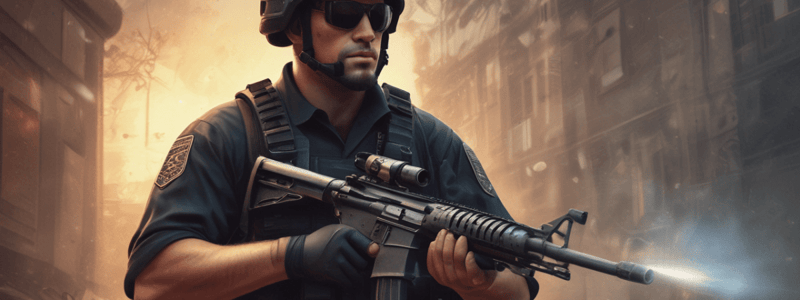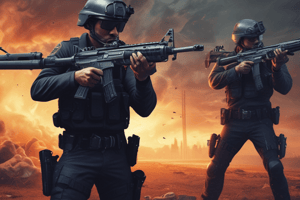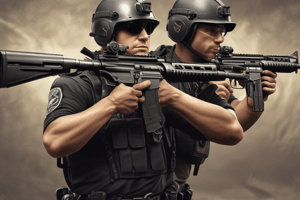Podcast
Questions and Answers
What is the primary consideration in the training environment of the Nightfire Handgun Shotgun course?
What is the primary consideration in the training environment of the Nightfire Handgun Shotgun course?
- Safety first (correct)
- Speed
- Operator awareness
- Accuracy
What is the main emphasis of the night fire training course?
What is the main emphasis of the night fire training course?
- Decision-making process
- Target identification and firing discipline (correct)
- Stress combat-type courses
- Officer survival tactics
Why is it important to treat all firearms as if they are loaded?
Why is it important to treat all firearms as if they are loaded?
- To conserve ammunition
- To prevent accidental discharge (correct)
- To maintain accuracy
- To ensure speed in handling the firearm
What is the correct direction to point the muzzle of a firearm when handling it?
What is the correct direction to point the muzzle of a firearm when handling it?
When is it acceptable to put your finger inside the trigger guard?
When is it acceptable to put your finger inside the trigger guard?
What is the purpose of target identification in the night fire training course?
What is the purpose of target identification in the night fire training course?
What is the recommended distance for firing the course on most ranges?
What is the recommended distance for firing the course on most ranges?
What is the importance of being aware of what is beyond the target?
What is the importance of being aware of what is beyond the target?
What is the primary rule when handling firearms?
What is the primary rule when handling firearms?
Why must a police officer be physically and mentally prepared when discharging a firearm?
Why must a police officer be physically and mentally prepared when discharging a firearm?
What should you do when handed a firearm?
What should you do when handed a firearm?
What is the purpose of a 'cold' range?
What is the purpose of a 'cold' range?
What should you do if a 'hang fire' occurs?
What should you do if a 'hang fire' occurs?
What is a 'squib fire' or 'squib load'?
What is a 'squib fire' or 'squib load'?
Why is it important to maintain muzzle direction and control?
Why is it important to maintain muzzle direction and control?
What should you never do while on the firing line?
What should you never do while on the firing line?
What should you do if you need to carry a shotgun on the range?
What should you do if you need to carry a shotgun on the range?
What is the preliminary step before using the firing line?
What is the preliminary step before using the firing line?
What is the consequence of being under the influence of alcohol or drugs on the range?
What is the consequence of being under the influence of alcohol or drugs on the range?
What is the purpose of wearing eye and hearing protection on the firing line?
What is the purpose of wearing eye and hearing protection on the firing line?
What phrase should be yelled out in case of a problem during dim-light shooting?
What phrase should be yelled out in case of a problem during dim-light shooting?
What is the command given to direct the shooter to load the firearm?
What is the command given to direct the shooter to load the firearm?
What is the purpose of the command 'CEASE FIRE'?
What is the purpose of the command 'CEASE FIRE'?
When can the shooter move from their shooting station during dim-light shooting?
When can the shooter move from their shooting station during dim-light shooting?
What is the procedure to follow when not wishing to fire a round?
What is the procedure to follow when not wishing to fire a round?
What is the purpose of the command 'HOLSTER'?
What is the purpose of the command 'HOLSTER'?
What is the purpose of the 'IS THE LINE SAFE?' question?
What is the purpose of the 'IS THE LINE SAFE?' question?
What is the requirement for shotgun shooting?
What is the requirement for shotgun shooting?
What conditions are required for a safe action?
What conditions are required for a safe action?
What is the worst hour for violent crimes to occur?
What is the worst hour for violent crimes to occur?
Why is target identification essential in low-light situations?
Why is target identification essential in low-light situations?
What affects the eyes' ability to see in low-light conditions?
What affects the eyes' ability to see in low-light conditions?
How long does it take for rod cells to produce night vision?
How long does it take for rod cells to produce night vision?
What is the purpose of off-centered vision in low-light situations?
What is the purpose of off-centered vision in low-light situations?
When is instinct shooting used in low-light situations?
When is instinct shooting used in low-light situations?
What is the primary concern in dim-light shooting exercises?
What is the primary concern in dim-light shooting exercises?
What is the result of focusing directly on an object in low light?
What is the result of focusing directly on an object in low light?
What is the purpose of scanning in low-light situations?
What is the purpose of scanning in low-light situations?
What is the role of cone cells in the eyes?
What is the role of cone cells in the eyes?
What affects night vision?
What affects night vision?
What is the purpose of off-centered vision?
What is the purpose of off-centered vision?
What is instinct shooting?
What is instinct shooting?
What is the purpose of using light behind the target/suspect?
What is the purpose of using light behind the target/suspect?
How can you speed up the recovery of night vision?
How can you speed up the recovery of night vision?
What is the purpose of using a flashlight in night fire techniques?
What is the purpose of using a flashlight in night fire techniques?
What happens when you focus directly at an object in low light?
What happens when you focus directly at an object in low light?
How do you align the sights using silhouette light?
How do you align the sights using silhouette light?
What is dark adaptation?
What is dark adaptation?
When acquiring the target and your front sight, what should you do with the flashlight?
When acquiring the target and your front sight, what should you do with the flashlight?
When using the silhouette light technique, what should you align the gun's sights with?
When using the silhouette light technique, what should you align the gun's sights with?
What is the primary benefit of using a flashlight with a slide and push-button control?
What is the primary benefit of using a flashlight with a slide and push-button control?
According to the FBI method, how should the gun and flashlight be held?
According to the FBI method, how should the gun and flashlight be held?
What is the recommended action to take after firing a shot while using a flashlight?
What is the recommended action to take after firing a shot while using a flashlight?
What is the primary consideration when using a flashlight in a shooting situation?
What is the primary consideration when using a flashlight in a shooting situation?
What is the recommended technique for acquiring the target and the front sight when using a flashlight?
What is the recommended technique for acquiring the target and the front sight when using a flashlight?
What is the primary benefit of using a flashlight with a dark color?
What is the primary benefit of using a flashlight with a dark color?
What is the recommended shooting technique when using a flashlight in a shooting situation?
What is the recommended shooting technique when using a flashlight in a shooting situation?
What is the primary difficulty in mastering the flashlight shooting technique?
What is the primary difficulty in mastering the flashlight shooting technique?
What is the primary benefit of the Harries method in shooting techniques?
What is the primary benefit of the Harries method in shooting techniques?
When is the worst hour for violent crimes to occur according to the text?
When is the worst hour for violent crimes to occur according to the text?
What is the primary reason for target identification in night fire training?
What is the primary reason for target identification in night fire training?
Why is firing discipline critical in dim light or night time shootings?
Why is firing discipline critical in dim light or night time shootings?
What is the effect of light on the eyes in dim light or night time shootings?
What is the effect of light on the eyes in dim light or night time shootings?
What is the purpose of the 'line is ready' signal in night fire training?
What is the purpose of the 'line is ready' signal in night fire training?
What is the recommended approach to practicing techniques in night fire training?
What is the recommended approach to practicing techniques in night fire training?
Why is it important to keep the range silent during night fire training?
Why is it important to keep the range silent during night fire training?
What is the primary concern in night fire training?
What is the primary concern in night fire training?
What is the recommended approach to handling gear during night fire training?
What is the recommended approach to handling gear during night fire training?
What is the recommended position for the officer in relation to the light source when using vehicle strobes, rotators, or flashers?
What is the recommended position for the officer in relation to the light source when using vehicle strobes, rotators, or flashers?
What is the key to using the light from vehicle strobes, rotators, or flashers effectively?
What is the key to using the light from vehicle strobes, rotators, or flashers effectively?
What is an important consideration when selecting a flashlight for police duty?
What is an important consideration when selecting a flashlight for police duty?
What should the officer do after using the light to acquire the target/suspect and the front sight in a shooting situation?
What should the officer do after using the light to acquire the target/suspect and the front sight in a shooting situation?
What is the primary difference between the old and new FBI methods of flashlight shooting?
What is the primary difference between the old and new FBI methods of flashlight shooting?
What is the characteristic of the Ayoob method of flashlight shooting?
What is the characteristic of the Ayoob method of flashlight shooting?
What is the characteristic of the Ray Chapman method of flashlight shooting?
What is the characteristic of the Ray Chapman method of flashlight shooting?
What is the characteristic of the Harries' method of flashlight shooting?
What is the characteristic of the Harries' method of flashlight shooting?
What is the benefit of using the flashlight technique in shooting situations?
What is the benefit of using the flashlight technique in shooting situations?
What is an important consideration when using a flashlight in shooting situations?
What is an important consideration when using a flashlight in shooting situations?
Flashcards are hidden until you start studying
Study Notes
Night Fire Handgun Shotgun Training
Introduction
- Night fire training is designed to introduce trainees to realistic encounter times and light conditions.
- Emphasis on target identification and firing discipline.
Firearms Range Safety Rules and Guidelines
- Safety first: total operator awareness of the firearm at all times.
- Four critical safety rules:
- Treat all firearms as if they are loaded.
- Point the muzzle in a safe direction (down range) or at the target.
- Keep your finger outside of the trigger guard and off the trigger until on target and ready to fire.
- Always be sure of your target and aware of what is beyond the target.
- Additional safety rules:
- No smoking, eating, or drinking on the firing line.
- No alcohol or drug consumption.
- No talking on the firing line except by range instructors.
- Handguns must remain in holsters unless on the firing line.
- No magazine or ammunition in the weapon when carrying it on the range.
Range Commands
- LOAD: command to load the firearm.
- STAND BY: command to assume the starting position.
- READY: alert to the next command.
- FIRE: command to perform the string of fire.
- CEASE FIRE: command to stop firing immediately.
- GO FORWARD: command to move forward after the firing line is safe.
- HOLSTER: command to holster a safe weapon.
- UNLOAD: command to unload the firearm and complete a "condition check".
- AT EASE: command to stop a series of commands and await further instructions.
Dim-Light Shooting Considerations
- Most violent crimes occur at night or in low light conditions.
- Target identification is crucial.
- Firing discipline is critical in low light conditions.
- Light (or lack of it) affects the eyes in a predictable way.
- Depth perception is distorted in low light conditions.
- Day firing techniques need to be modified in low light conditions.
Night Vision and Techniques
- The eyes use cone cells in bright light and rod cells in low light.
- Vitamin A, exposure to bright lights, and certain conditions can affect night vision.
- Principles of night vision:
- Dark adaptation.
- Off-centered vision.
- Instinct shooting can be used at night.
- Night fire techniques:
- Using light on the face of the target/suspect.
- Using light behind the target/suspect (silhouette light).
- Using a flashlight to acquire the target and sights.
- Using light from vehicle strobes, rotators.
Flashlight Shooting Techniques
- Four basic styles:
- The FBI method (old and new).
- The Ayoob method.
- The Ray Chapman method.
- The Harries method.
- Considerations:
- Using the flashlight to acquire the target and sights.
- Turning off the light after firing.
- Moving after firing.
- Using the light to control the suspect.
- Practice is crucial to master flashlight shooting techniques.
Live Fire Procedures
- Will be determined by academy/department policy.
- Exercises to start with the gun holstered or drawn.
- Emphasis on safety and proper technique.### Night Fire Techniques
- Dim light or night time shootings require awareness of specific concerns:
- Majority of violent crimes occur at night or in low light conditions
- Worst hours are from 9 pm to 3 am, with the worst hour being 11 pm to 12 midnight
- Target identification is crucial
- Firing discipline is critical to avoid premature shooting and to cease firing when the target is no longer visible
Night Vision
- Light affects the eyes in a predictable way:
- Day firing techniques need to be modified in low light conditions
- Objects appear faint, lack sharpness, and lack color in low light
- Eye makeup and construction affect vision:
- Cone cells allow for color, shape, and contrast vision in bright light
- Rod cells produce "night vision" in low light, allowing for black and white, shades of gray, and general outlines
- Factors affecting night vision:
- Vitamin A deficiency
- Exposure to bright lights
- Colds, headaches, fatigue, narcotics, heavy smoking, and excessive alcohol use
- Principles of night vision:
- Dark adaptation takes about 30 minutes to produce rod cells
- Off-centered vision helps to focus on objects without staring directly
Instinct Shooting
- Instinct shooting (point shooting) can be used at night:
- Officer must be close enough to identify the suspect and justify the use of deadly force
- Proper foot positioning and body stance are necessary for center mass hits
Night Fire Techniques
- Using available light to acquire target acquisition and a sight picture:
- Light on the face of the target/suspect
- Light behind the target/suspect (using silhouette light)
- Using a flashlight to acquire the target and align the sights
- Light coming from vehicle strobes, rotators, or flashers
Flashlight Techniques
- Establishing a good flashlight shooting-grip technique:
- Use the light sparingly to identify the threat and to see the front sight
- Get the light off as soon as possible after acquiring the target
- Move after firing, if possible
- Four flashlight shooting techniques:
- The FBI method (old and new)
- The Ayoob method
- The Ray Chapman method
- The Harries' method
Studying That Suits You
Use AI to generate personalized quizzes and flashcards to suit your learning preferences.




